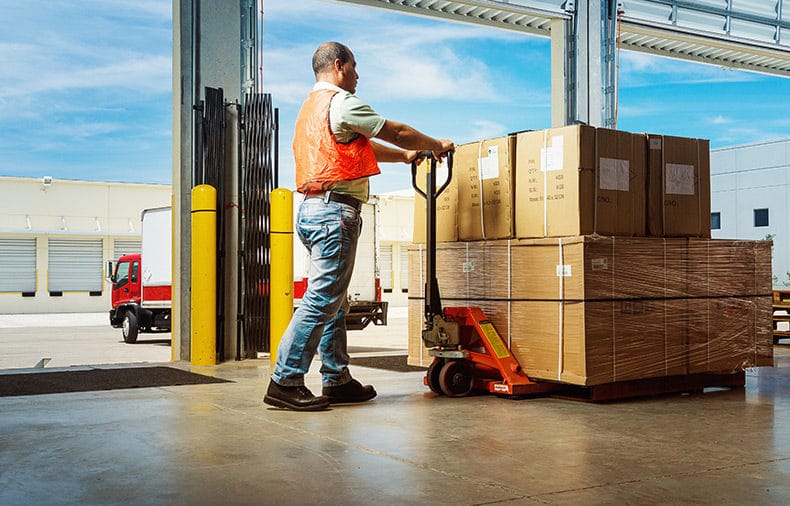HOW TO MEASURE FREIGHT FOR TRANSPORT
Measuring boxes, pallets, and crated freight is often confusing for beginners. If you do not know how to measure your freight properly, you risk paying additional fees after delivery.
When freight is transported, it stops at many shipping terminals. At those terminals, your freight is measured with high-tech lasers and weighed with government-regulated scales. For this reason, it’s extremely important to provide concise measurements when shipping freight.
Measuring the weight, length, girth, cubic size, and dimensional weight of your shipment will help you decide which shipping services work best for you. For example, parcel services have dimensional limitations. That is, you cannot ship certain oversized items. Furthermore, shipping your freight via parcel may be more or less expensive than truckload services.
After reading this guide, you will be able to properly measure freight, calculate volume, and density for pallets, boxes, and crates. Once you have finished measuring your freight, use our price calculator to find out how much it will cost to ship your freight.
HOW TO MEASURE PALLET DIMENSIONS
To measure a pallet, you will need the following items:
- Tape Measure: Any tape measure works, just be sure it’s long enough to get the job done.
- Something to write on: Excel spreadsheets are great for this, but if you would rather rip off a piece of cardboard, that works too.
To measure a pallet:
- Measure pallet length: Length is how long your pallet is. There are two possible ways to measure the length of a pallet depending on how your goods are stacked. If your goods are stacked without any overhang, start and end your measurement at the base of the pallet. Otherwise, if overhang is present, start and end the measurement based on the goods, not the pallet.
- Measure pallet width: Width is how wide your pallet is. This measurement will typically be less than your length. There are two possible ways to measure the width of a pallet depending on how your goods are stacked. If your goods are stacked without any overhang, start and end your measurement based on the pallet itself. Otherwise, if overhang is present, start and end the measurement based on the goods, not the pallet.
- Measure pallet height: Height is how tall your shipment is overall. Start the measurement at the bottom of your pallet and end it at the top of your goods.
- Record pallet measurements: Write your measurements down for later use. If you ship the same products often, creating an Excel product spreadsheet with dimensions will help save you time.
HOW TO MEASURE CRATE DIMENSIONS
To measure a crate, you will need the following items:
- Tape Measure: Any tape measure works, just be sure it’s long enough to get the job done.
- Something to write on: Excel spreadsheets are great for this, but if you would rather tear off a piece of cardboard, that works too.
To measure a pallet:
- Measure crate length: Length is how long your crate is. There are four possible ways to measure the length of a crate. When your crate is on a pallet, and there is no overhang, start and end your measurement at the base of the pallet, end to end. If your crate is on a pallet, and there IS overhang, measure the longest part of the crate, end to end. If you’re just shipping a crate, measure the longest part of the crate, end to end.
- Measure crate width: Width is how wide your crate is. There are four possible ways to measure the width of a crate. When your crate is on a pallet, and there is no overhang, start and end your measurement at the base of the pallet, end to end. If your crate is on a pallet and there IS overhang, measure the crate end to end. If you’re just shipping a crate, measure the crate from end to end.
- Measure crate height: Height is how tall your cargo is overall. There are two ways to do this. If you are shipping a crate on a pallet, start the measurement at the bottom of your pallet end it at the top of your crate. Otherwise, if you are shipping a crate without a pallet, measure from the bottom of the crate to the top.
- Record crate measurements: Write your measurements down for later use. If you ship the same products often, creating an Excel product spreadsheet with dimensions will help save you time.
Want to learn how to crate freight? Read our guide on crating and shipping freight.
HOW TO MEASURE A BOX FOR SHIPPING
To measure a box, you will need the following items:
- Tape Measure: Any tape measure works, just be sure it’s long enough to get the job done.
- Something to write on: Excel spreadsheets are great for this, but if you would rather tear off a piece of cardboard, that works too.
To measure a box:
- Measure box length: Length is how long your box is. There are four possible ways to measure the length of a box. When your box is on a pallet, and there is no overhang, start and end your measurement at the base of the pallet, end to end. If your box is on a pallet, and there IS overhang, measure the longest part of the box, end to end. If you’re just shipping a box, measure the longest part of the box, end to end.
- Measure box width: Width is how wide your box is. There are four possible ways to measure the width of a box. Boxes on a pallet with overhang: start and end your measurement at the base of the pallet, end to end. If your box is on a pallet, and there IS overhang, measure the box end to end. If you’re just shipping a box, measure the box end to end.
- Measure box height: Height is how tall your freight is overall. There are two ways to do this. If you are shipping a box on a pallet, start the measurement at the bottom of your pallet end it at the top of your box. Otherwise, if you are shipping a box without a pallet, measure from the bottom of the box to the top.
- Record pallet measurements: Write your measurements down for later use. If you ship the same products often, creating an Excel product spreadsheet with dimensions will help save you time.
That’s it.
If you need to calculate the density or volume, keep reading.

CALCULATE THE VOLUME OF A PALLET, BOX, OR CRATE
Calculating the volume of a pallet, box, or crate is simple. Simply multiply the length by the width by the height. If you need help measuring your freight, please see above for specifics.
Example: A pallet measures 40 inches long, 48 inches wide, and 50 inches high. To find the volume, multiple 40 (length) by 48 (width) by 50 (height), thus 40x48x50=96,000 cubic inches
CALCULATE THE VOLUME OF A PALLET, BOX, OR CRATE
Calculating the volume of a pallet, box, or crate is simple. Simply multiply the length by the width by the height. If you need help measuring your freight, please see above for specifics.
Example: A pallet measures 40 inches long, 48 inches wide, and 50 inches high. To find the volume, multiple 40 (length) by 48 (width) by 50 (height), thus 40x48x50=96,000 cubic inches

CALCULATE THE DENSITY OF A PALLET, BOX, OR CRATE
Freight carriers sometimes use dimensional weight instead of actual weight. Furthermore, the dimensional weight reflects the amount of space a container takes up relative to its real weight. For example, the “weight” for shipping a box full of inflated rubber balls would be based on dimensional weight instead of actual weight.
To calculate dimensional weight, divide the cubic size (LxWxH) by 139 (166 for international freight shipments).
Example: (48″x48″x48″)/139 = 796 pounds
CALCULATE THE DENSITY OF A PALLET, BOX, OR CRATE
Freight carriers sometimes use dimensional weight instead of actual weight. Furthermore, the dimensional weight reflects the amount of space a container takes up relative to its real weight. For example, the “weight” for shipping a box full of inflated rubber balls would be based on dimensional weight instead of actual weight.
To calculate dimensional weight, divide the cubic size (LxWxH) by 139 (166 for international freight shipments).
Example: (48″x48″x48″)/139 = 796 pounds
FAQ
In what order do dimensions go?
The order of dimensions is as follows: Length, Width, and Height.
What is the size of a shipping pallet?
The size of a standard shipping pallet is 48×40 inches. The height will depend on your shipment.
How much does a standard shipping pallet weigh?
The weight of a standard pallet is between 33 and 48 pounds.
How big is a shipping pallet?
The average shipping pallet is 48×40 inches and weighs 35 pounds. However, shipping pallets can range in size and weight depending on the type of pallet.
Still have questions about measuring pallets, crates, or boxes? Contact us.
WHY USHIP?
Not only does uShip provide discounted freight quotes, but we also offer other great benefits, such as:
- Rebill Protection: uShip audits your invoice to ensure no mistakes were made. In addition, if you do not agree with an additional charge, we will assist you in disputing it with your carrier directly.
- Load Your Own Rates: If you have your own rates with LTL carriers, you can load them directly into your uShip portal, allowing you to compare quotes all in one place.
- Customer Specific Rates: We can negotiate pricing with carriers based on your individual volume.
- Referral Program: You will receive shipping credit when you refer a friend.
- Insurance: Did you know LTL carriers do not have full liability insurance? It’s always best to cover your freight with a uShip cargo insurance policy.
From competitive prices to great customer service, it’s clear why so many small businesses prefer obtaining LTL freight quotes from uShip.
Need to Ship?
Get Instant QuotesRelated Articles

When shipping freight, carriers typically require your goods to be transported on a pallet. Pallets are portable bases used for freight shipping to transport multiple packaged items or containers.

It’s no secret that shipments are often damaged due to being mishandled during the transport process. One way to protect your cargo is to crate it.

A bill of lading, or BOL for short, is a transport document that is required for shipping freight. A BOL can be defined as a receipt for services rendered during a freight shipment.